Half-awake in bed this morning I was lifted out of my dreams by an item on the Radio 4 Today programme, about Harmondsworth Great Barn, which has apparently been bought for the nation for a knock-down £20,000. It’s a sum that would hardly buy a garage or a garden shed out here in West London, and the barn is notable among other respects in its size. I think the BBC reporter said it was 20 metres long, which she helpfully added is almost 60 feet. Or as we say in the real world, just over 65 ft. But it was early morning and I could be wrong. On the ground the barn is over 60 metres long – 192 ft – and 11 metres high (37 ft) really giving the impression of a vast wooden cathedral (John Betjeman called it ‘The Cathedral of Middlesex‘, with a central nave and two side aisles giving a total width of around 12 metres (38 ft.) Its 12 bays are supported by giant oak columns, whole trees selected and cut to shape, with a tremendous amount of woodwork, of which over 95% is thought to date from 1426 when the barn was built by Winchester College to house the vast yield of wheat from its lands.
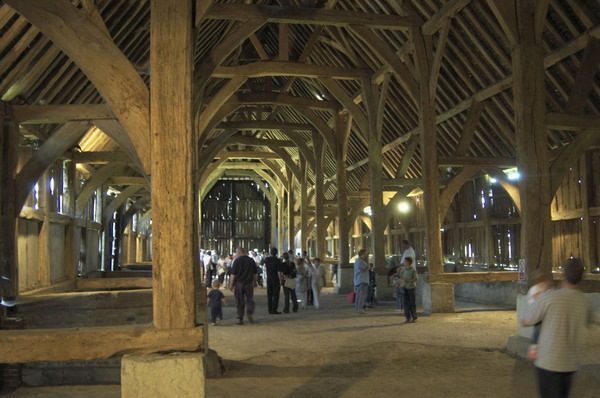
The people give a good indication of the size of the Great Barn
It was a typical BBC report, sprinkled with such inaccuracies – she spent some time telling us we might have flown over it on our way in or out of Heathrow, and about the planes flying overhead. Unless they take a sharp left or right halfway down the runway they don’t – the Great Barn is 1.3 km directly north of the northern runway. You can hear the planes, see them shortly after they leave or reach the ground, but they don’t go overhead either on take-off or landing. That treat is reserved mainly for the residents of Hounslow and London to the east and Poyle and other places to the west.
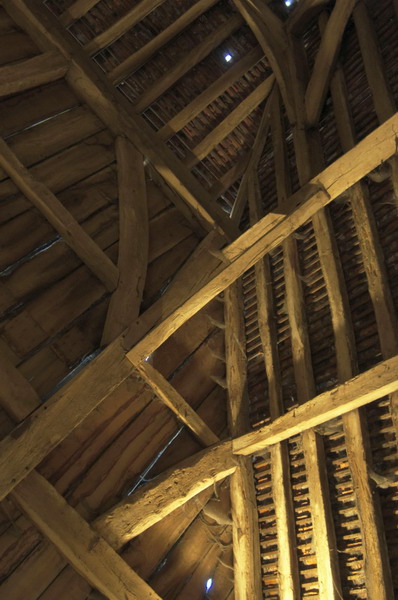
Splendid oak beams, cut in 1426 support the tiled roof.
In truth English Heritage paid £199,999 more of our money than they needed to, as they were offered the Great Barn for £1 in 2003, but amazingly declined to buy. The Guardian quotes Simon Thurley, chief executive of EH as saying “Harmondsworth Barn is one of the greatest medieval buildings in Britain, built by the same skilled carpenters who worked on our magnificent medieval cathedrals. Its rescue is at the heart of what English Heritage does.” You would have thought it would have been worth a quid – particularly before the recession and the cuts! Three years later the owners were bankrupt and it was bought by a trust who paid a pound for it, and more or less left it to rot, presumably hoping to make money from the sale of the site for the airport extension.
The site, as the Society for the Protection of Ancient Buildings, (better known as SPAB) explains, is both a Grade One listed building and a Scheduled Ancient Monument (SAM). Unfortunately the SAM listing means that enforcement powers which can be used against owners of listed buildings to force repairs do not apply. Bizarrely there are no comparable powers for SAMs, which have to rely on the slow process of English Heritage getting permission from the Department for Culture, Media and Sport to get things done. Although it had been well-maintained until around 2003, since then it has been neglected, falling to pieces over the past 8 or 9 years and costing us more to put right.
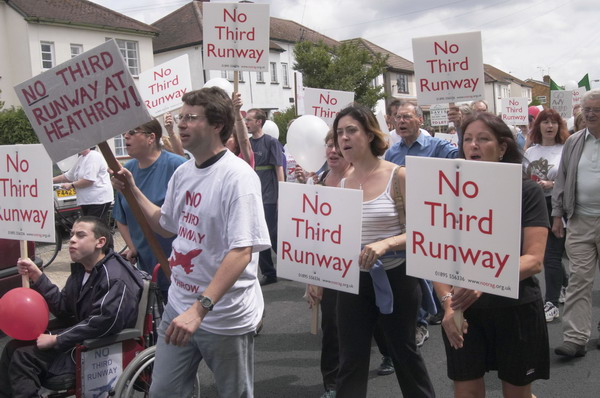
Protesters march from Harlington to a rally at Harmondsworth in 2003
The most significant omission from the BBC report was any mention of the fight to stop the third runway at Heathrow – its western end would have been just a few metres from the barn and the church a few yards away. As well as the runway, the plans also included the building of a new and busy road past the site. At the moment it’s just off a quiet (apart from the planes three-quarters of a mile away) triangular village green with pub, church and cottages on a road that leads to nowhere – on a bike you can continue to Harmondsworth Moor and walk or ride along by the River Colne or the Wraysbury River, an area of grass and woodland away from anywhere except aurally, with the noise of the planes largely drowned by the continual rumble of the M25 and M4!
I visited the barn and took pictures inside it on the day of the first large protest march against the third runway. We held the rally on the green outside the pub, and there was a specially brewed beer for the campaign. Despite the closeness of the airport, the area retains something of the character of the Middlesex villages I rode through on my bike as a boy in the 1950s.
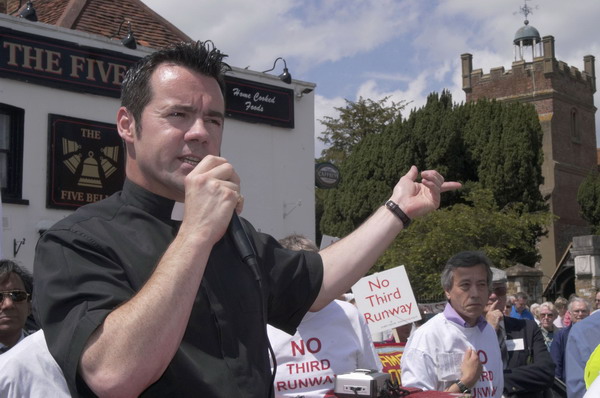
The rally on Harmondsworth’s village green, outside the Five Bells – the barn is just a few yards down past the right of the pub
Even in the fifties, we knew that Heathrow Airport was in the wrong place for London’s major airport as the planes thundered over shaking our Hounslow house just two and a half miles from touchdown. The aviation industry who planned it in the 1940s knew that they could only get it there by stealth, under the pretence it was needed for military purposes, a deliberate deception which has since been acknowledged. By the 1980s and 90s the need to build a new airport was so clear that it seems criminal that successive governments ignored it. Then as now, the obvious site was not ‘Boris island‘ but somewhere to the north-west of London, close to the M1 and the west coast mainline, perhaps in an area already despoiled by abandoned brick workings, and with flight paths that avoid our major centres of population. But government after government fudged the issue and instead gave way to pressure from the aviation industry to expand Heathrow, terminal by terminal, each one promised to be the final expansion. It’s long past time we got a vision for the future of Heathrow that looks at the site as an opportunity for a future new town rather than as an airport.
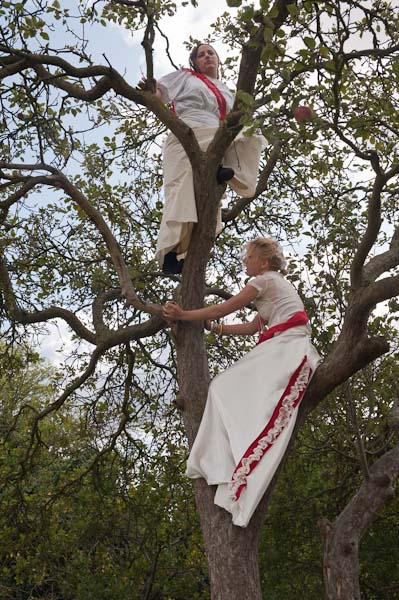
Climate Rush scrumping at the nearby Heathrow Airplot, September 2009
The Great Barn has for some years only been open on special occasions – mainly the annual Open House Day. According to The Guardian report cited above, it will be open two Sundays a month from April, free to the public, thanks to volunteers from the local Friends of Harmondsworth Barn, and it is well worth a visit, though I hope there will not be too many cars blocking the local lane’. There is a car park for the Colne Valley park a fairly short walk away which I hope visitors will be encouraged to use. I hope too you will be able to enjoy fruit from the adjoining orchard, seldom harvested in recent years, which Grow Heathrow paid a visit last October. Before the airport, this was an area famed for its market gardens and orchards, one of the agriculturally most productive areas of the country (and the home of the ultimate apple, Cox’s Orange Pippin – and Richard Cox was buried in the churchyard) – which is why Winchester needed such a huge barn.